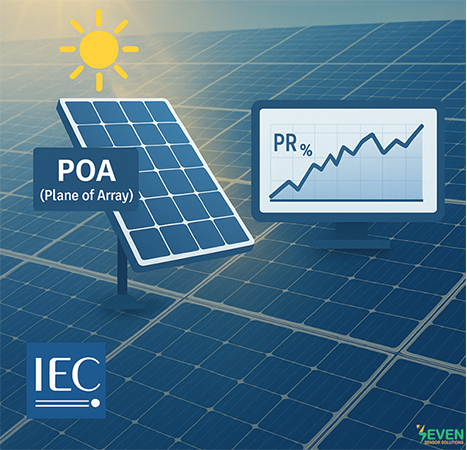The efficient and sustainable operation of photovoltaic (PV) systems is possible with accurate and reliable performance monitoring. The selection of photovoltaic (PV) sensors is of great importance for accurately monitoring GES performance. In this context, the IEC 61724-1:2021 standard stands out as an international reference standard for PV system performance monitoring processes. This standard provides guidance to users in a wide range of areas, from sensor requirements to data processing methods.
In particular, the SEVEN Sensor Solution 3S-TP-MB-A thermopile pyranometer data used to measure solar radiation is critical for evaluating system performance. This article describes photovoltaic system performance analysis methods using a daily Plane of Array (POA) data set in accordance with the IEC 61724-1 standard.
Performance Monitoring According to IEC 61724-1 Standard
IEC 61724-1 defines two levels for monitoring the performance of photovoltaic power plants: Class A and Class B. Each class has different requirements in terms of sensor type, data collection frequency, and maintenance frequency.
- Class A monitoring systems must use high-precision pyranometers classified according to ISO 9060:2018.
- Data recording frequency is recommended to be every 1 minut


“Tables 1 and 2 are included in the IEC61724:2021 standard. The table is used directly without any modification.”
What is POA (Plane of Array) Data?
POA data represents the solar irradiance falling on the plane of the solar panels and is a fundamental input for PV system performance analysis. POA data is typically obtained from Global Horizontal Irradiance (GHI) data measured on a horizontal plane, corrected for tilt and orientation, or measured directly using pyranometers mounted on the panel plane. For more information on how the SEVEN Termopil Pyranometer is mounted as POA, please refer to our article.
How to Calculate Performance Ratio (PR) with POA Irradiance?
One of the most commonly used metrics for measuring the efficiency of PV systems is the Performance Ratio (PR). PR reflects the actual production performance of the system compared to its expected performance.
The PR formula is as follows:

Example:
- POA Irradiance: 5 kWh/m²
- PV Installed Power: 100 kWp
- Real Energy Production: 420 kWh
PR = (420 / (5 × 100)) × 100 = 84%
According to the sample calculation, the performance ratio is 84%. This calculation shows how effectively the system works in relation to solar radiation.
What Are the Analysis Methods for One Day of POA Data?
It is possible to perform meaningful analyses even with one day of data. Here are the methods you can apply:
1. Hourly PR Analysis
By grouping POA data and production data by the hour, you can see which time intervals experienced low efficiency.
2. Data Anomaly Detection
During one-day measurements, anomalies such as sensor malfunctions, panel shading, or inverter outages may manifest as fluctuations in PR.
3. Cleaning and Maintenance Planning
By comparing POA data with PR trends, issues such as panel soiling can be identified. This highlights the importance of regular cleaning and calibration. Our article explains the losses that can result from neglecting the necessary cleaning and calibration intervals.
The IEC 61724-1 standard provides a technical and methodological framework for the reliable monitoring of photovoltaic systems. It is indispensable for POA data, PR calculations, and system analysis. Even with just one day’s worth of data, it is possible to gain important insights. By regularly analyzing your Termopil Pyranometer and meteorological sensor data, you can detect performance issues early and maintain maximum system efficiency.
As Seven Sensor, we offer the high-accuracy SEVEN 3S-TP-MB-A Thermopile Pyranometer and all meteorological sensor solutions compliant with IEC 61724-1 and ISO 9060:2018 standards. For detailed information and our products, please contact us.
Frequently Asked Questions (FAQ)
1. What is the difference between POA data and GHI data?
GHI measures the total solar radiation reaching the horizontal plane, while POA represents the radiation reaching the module plane. POA is more meaningful for evaluating actual system performance.
2. Why does PR not reach 100%?
Production losses occur due to reasons such as module heating, inverter losses, cable resistance, contamination, and shading. Therefore, PR does not reach 100% theoretically.
3. Is IEC 61724-1 a mandatory standard?
No, but it is widely preferred by EPC companies and investors for quality control and acceptance testing.
